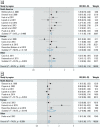Outdoor particulate matter exposure and lung cancer: a systematic review and meta-analysis
- PMID: 24911630
- PMCID: PMC4154221
- DOI: 10.1289/ehp/1408092
Outdoor particulate matter exposure and lung cancer: a systematic review and meta-analysis
Erratum in
- Environ Health Perspect. 2014 Sep;122(9):A236
Abstract
Background: Particulate matter (PM) in outdoor air pollution was recently designated a Group I carcinogen by the International Agency for Research on Cancer (IARC). This determination was based on the evidence regarding the relationship of PM2.5 and PM10 to lung cancer risk; however, the IARC evaluation did not include a quantitative summary of the evidence.
Objective: Our goal was to provide a systematic review and quantitative summary of the evidence regarding the relationship between PM and lung cancer.
Methods: We conducted meta-analyses of studies examining the relationship of exposure to PM2.5 and PM10 with lung cancer incidence and mortality. In total, 18 studies met our inclusion criteria and provided the information necessary to estimate the change in lung cancer risk per 10-μg/m3 increase in exposure to PM. We used random-effects analyses to allow between-study variability to contribute to meta-estimates.
Results: The meta-relative risk for lung cancer associated with PM2.5 was 1.09 (95% CI: 1.04, 1.14). The meta-relative risk of lung cancer associated with PM10 was similar, but less precise: 1.08 (95% CI: 1.00, 1.17). Estimates were robust to restriction to studies that considered potential confounders, as well as subanalyses by exposure assessment method. Analyses by smoking status showed that lung cancer risk associated with PM2.5 was greatest for former smokers [1.44 (95% CI: 1.04, 1.22)], followed by never-smokers [1.18 (95% CI: 1.00, 1.39)], and then current smokers [1.06 (95% CI: 0.97, 1.15)]. In addition, meta-estimates for adenocarcinoma associated with PM2.5 and PM10 were 1.40 (95% CI: 1.07, 1.83) and 1.29 (95% CI: 1.02, 1.63), respectively.
Conclusion: The results of these analyses, and the decision of the IARC Working Group to classify PM and outdoor air pollution as carcinogenic (Group 1), further justify efforts to reduce exposures to air pollutants that can arise from many sources.
Conflict of interest statement
The views expressed in this article do not necessarily represent those of the HEI or its sponsors.
The authors declare they have no actual or potential competing financial interests.
Figures

Comment in
-
Assessing the health threat of outdoor air: lung cancer risk of particulate matter exposure.Environ Health Perspect. 2014 Sep;122(9):A252. doi: 10.1289/ehp.122-A252. Environ Health Perspect. 2014. PMID: 25181733 Free PMC article. No abstract available.
References
-
- Buschini A, Cassoni F, Anceschi E, Pasini L, Poli P, Rossi C. Urban airborne particulate: genotoxicity evaluation of different size fractions by mutagenesis tests on microorganisms and comet assay. Chemosphere. 2001;44:1723–1736. - PubMed
Publication types
MeSH terms
Substances
Grants and funding
LinkOut - more resources
Full Text Sources
Other Literature Sources
Medical
Miscellaneous

